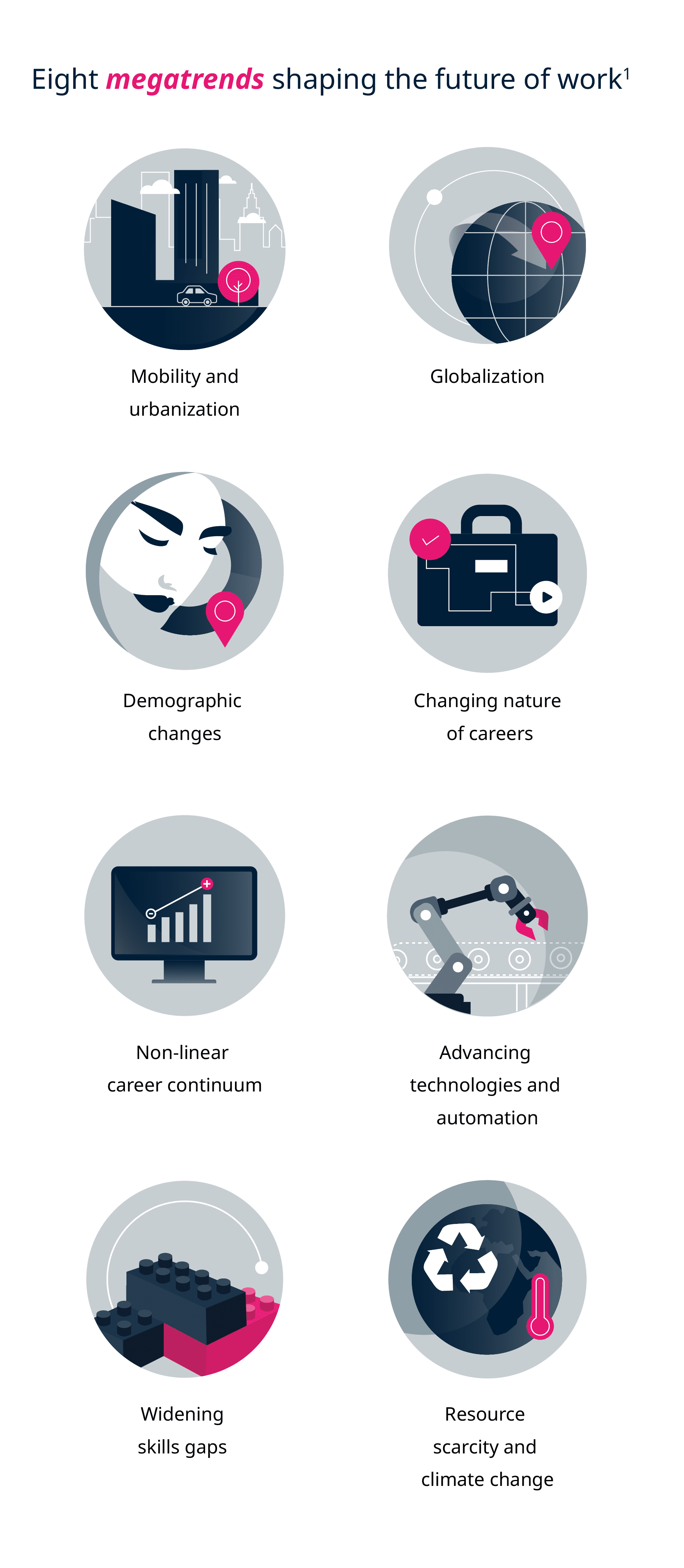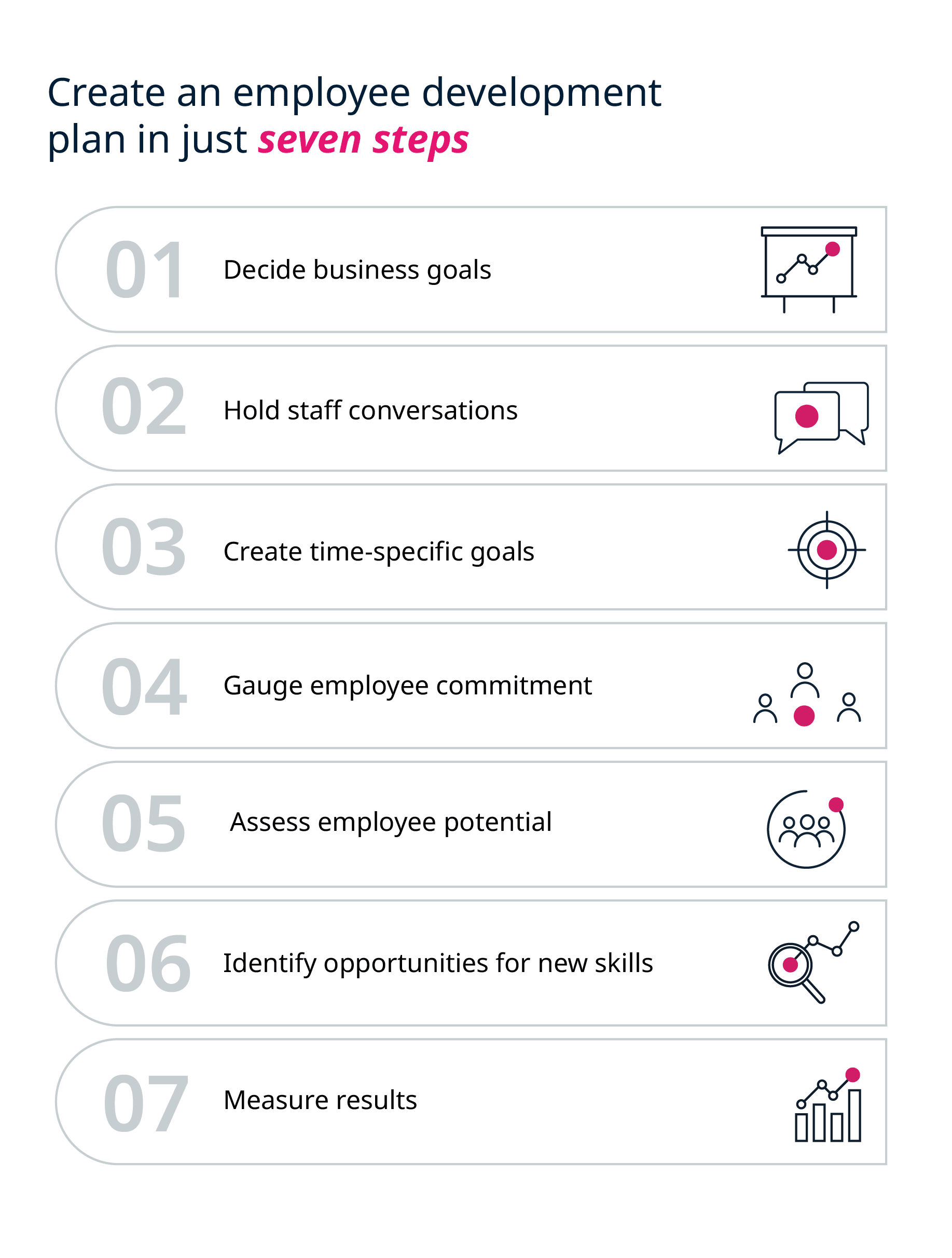Employee Training and Development: The Benefits of Upskilling or Reskilling Your Team
Talent development is vital to sustainable business growth and success. Organizations go through lengthy processes to recruit and onboard qualified and suitable employees, but often the emphasis stops there, with some business leaders disregarding the importance of developing their employees and nurturing their potential. Over the past few years, the world of work has been disrupted, initially and gradually, by the onset of the 4th Industrial Revolution and this disruption was accelerated by the impact of the COVID-19 pandemic.
Throughout these disruptions and transitions, eight megatrends have emerged that are shaping the future of work and impacting how businesses develop and engage with their employees.

With the advent of the Fourth Industrial Revolution (4IR), the staggering ramifications of the rapid integration of technological disruption and digital transformation has resulted in many businesses struggling to keep up with rapid innovation in the workplace. This, combined with widening skills gaps, is why actively investing in employee training and development is essential for both the growth of the business and the workforce that propels it. Filling the company’s skills gaps through the upskilling and reskilling of individuals or groups of employees, could be the difference between thriving or barely surviving through any change.
“Lots of companies don’t succeed over time. What do they fundamentally do wrong? They usually miss the future.” 2
– Larry Page, Google co-founder and computer scientist
What is employee development?
Employee training and development are terms often used interchangeably, across sectors, and encompass various employee learning practices. More specifically, employee training involves programs that enable employees to learn precise skills or gain knowledge to improve job performance. Employee development is a process whereby the manager and employee work together to create a development plan. This plan identifies areas to develop or enhance, and ascertains what actions or activities need to be taken to acquire and embed that learning. This development plan is aligned with the organization’s goals and ultimately serves as a template showing skills that the employee requires and how they can go about acquiring them. Now, more than ever, owing to the impact of the 4th Industrial Revolution and the COVID-19 pandemic, learning and development (L&D) in business is taking top priority in the workplace.
One of the biggest challenges faced by business leaders driving the adoption of disruptive technology, is insufficient internal skills when combining technology with technical proficiency. As industries innovate so new technologies emerge, which has a profound impact on education and development. The ability to merge new technology with creative learning methods will ensure that teams learn new skills or reskill dynamically, through a future-oriented approach.
Discover the five skills your team will need by 2025
The benefits of upskilling or reskilling your team
A changing world means that professional development will need to be constantly pursued and prioritized. Employers play an important role in supporting the acquisition of those skills. In fact, 54 percent of respondents from GetSmarter’s ‘The Future of Work Is Here’ report agree that upskilling or reskilling is the joint responsibility of the business and the employee.3
Here are four reasons why employee training and development is important:
1. Positive employee retention
The hiring and retention of talent can be an ongoing challenge for employers, however one way to retain your staff is by providing them with career development opportunities. Including development program offerings in employment contracts establishes an employee’s sense of value within the company, fostering loyalty and ultimately increasing staff retention. Investing in your staff’s professional development is not only vital for team retention, but learning and development professionals worldwide have reported that they’re observing a stronger appetite for upskilling than ever before.4
More than half the professionals surveyed by GetSmarter in 2020 say they’re either somewhat likely or very likely to change jobs in the next 12 months. Even more notable is that 51% claim they may change job functions or business areas entirely.5
2. Training future leaders
Acquiring leadership talent can start from the initial acquisition, or human resources professionals can select current employees as managerial candidates. Having established leadership development programs ensures that a business is always considering future organizational goals and succession planning by preparing promotable talent.
3. Employee empowerment
Recent research shows that leaders who inspire, ignite people’s imaginations, and mobilize them with a compelling vision are more impactful than managers who simply focus on the bottom line.6
4. Increased workplace engagement
Regular development initiatives can help keep employees motivated, while frequent training programs will also establish regular re-evaluation of employees, skills, and processes. Assessing the current skills and abilities within a team will enable managers to strategically plan targeted development programs that consider any potential skills gaps.
How to create a high-impact employee training plan
Companies that immediately engage in employee growth and potential learning opportunities – from the moment an individual is hired to the moment they leave – will greatly impact future employee performance and dedication.
“The most obvious solution to upping employee retention is creating more effective training and development programs. […] The main issue is that many of these programs aren’t designed with the user, or the employee, in mind.” 7
You can find out more about how to create an executive development plan in this GetSmarter article: How to Create an Executive Development Plan.
Here are four effective strategies for developing workplace talent:
1. Target soft skills
The latest GetSmarter 2021 report, which focuses on resetting professional careers in a COVID-19 world, found that training for soft skills and enhancing interpersonal (or more human) skills is a key trend for talent development in 2021 and the foreseeable future.8 Driving this is a surge of industry change, automation, and technological advancements. The modern workplace requires adaptable, critical thinkers who can communicate effectively and are aware of their value as well as their areas of development. The GetSmarter Skills Hierarchy enables you to identify individual or group strengths and areas of growth, and can reveal skills gaps in your team that need to be filled.
Build leadership and interpersonal skills
2. Personalize employee development
A few years ago, delivering tailored and sophisticated learning experiences at scale seemed out of reach, but modern talent development technology has made learning personalization a reality.9 Approaching workplace development with a one-size-fits-all mentality is counteractive to a growing, diversified workplace – employees need to be assessed on and acknowledged for their specific skills, technological fluency, and learning approach.
Build employee development skills
3. Emphasize digital learning
Employers need to reduce resistance to learning by engaging talent through the existing platforms they already choose to spend their time on. Agile learning methodologies that focus on speed, flexibility and collaboration are the future of learning and development. This is the approach that will enable leaders to better manage skills gaps by ensuring people are rapidly upskilled or reskilled for the benefit of work and business performance.10
Build digital transformation skills
4. Create a strategic development plan
According to the World Economic Forum, 50 percent of employees will need to be reskilled by 2025.11 As the skills gap continues to widen, employers need to take the initiative in training employees to reskill and upskill them. The steps involved in creating a development plan begin with establishing business goals. Upskilling and reskilling efforts can sustain and fuel company growth. In planning for future growth, and creating training solutions that target those goals, L&D needs to collaborate with all stakeholders to identify current and future skills gaps.12
Create an employee development plan in just seven steps

Regardless of whether a company has existing, functioning training programs, employee development won’t ever be effective if the work environment doesn’t accommodate – and encourage – continuous learning. Organizations need to support a culture of constant development that is able to recognize overall industry change and provide relevant training to overcome the challenges that may arise from such changes.
The benefits and value of training and development act like a domino effect; leaders feel competent and can efficiently influence employee performance; skilled and engaged employees result in high job satisfaction, commitment, and thus retention; workforce improvement and engagement benefits an organization’s overall profit. Despite the type of training and development provided, it needs to align with future workplace skills, support the company’s business objectives, and be delivered in an innovative way that mirrors the digital transformation in the business.
GetSmarter can guide you as your learning partner, and help your organization create a tailored upskilling or reskilling plan to meet your unique industry needs.
- 1 (2020). ‘The Future of Work Is Here’. Retrieved from GetSmarter.
- 2 (2021). ‘Top 39 Larry E. Page quotes’. Retrieved from Gracious Quotes.
- 3 (2020). ‘The Future of Work Is Here’. Retrieved from GetSmarter.
- 4 (2020). ‘Leading with learning: Insights and advice about the new state of L&D’. Retrieved from LinkedIn Learning.
- 5 (2021). ‘The Great Career Reset’. Retrieved from GetSmarter.
- 6 (2020). ‘Five ways to create an empowered workplace in 2021’. Retrieved from Fast Company.
- 7 (2020). ‘A better way to develop and retain top talent’. Retrieved from Harvard Business Review.
- 8 (2021). ‘The Great Career Reset’. Retrieved from GetSmarter.
- 9 (2020). ‘How technology enables personalized learning’. Retrieved from HR Technologist.
- 10 (2020). ‘Five learning and development trends to watch for in 2021’. Retrieved from Forbes.
- 11 (2020). ‘Trends 2021: Planning for the future of learning’. Retrieved from Training Industry.
- 12 (2020). ‘Trends 2021: Planning for the future of learning’. Retrieved from Training Industry.